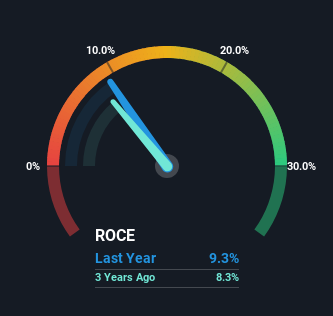- South Africa
- /
- Industrials
- /
- JSE:HCI
Here's What To Make Of Hosken Consolidated Investments' (JSE:HCI) Decelerating Rates Of Return
There are a few key trends to look for if we want to identify the next multi-bagger. One common approach is to try and find a company with returns on capital employed (ROCE) that are increasing, in conjunction with a growing amount of capital employed. Put simply, these types of businesses are compounding machines, meaning they are continually reinvesting their earnings at ever-higher rates of return. However, after investigating Hosken Consolidated Investments (JSE:HCI), we don't think it's current trends fit the mold of a multi-bagger.
What Is Return On Capital Employed (ROCE)?
Just to clarify if you're unsure, ROCE is a metric for evaluating how much pre-tax income (in percentage terms) a company earns on the capital invested in its business. Analysts use this formula to calculate it for Hosken Consolidated Investments:
Return on Capital Employed = Earnings Before Interest and Tax (EBIT) ÷ (Total Assets - Current Liabilities)
0.093 = R4.5b ÷ (R52b - R3.9b) (Based on the trailing twelve months to March 2023).
So, Hosken Consolidated Investments has an ROCE of 9.3%. In absolute terms, that's a low return and it also under-performs the Industrials industry average of 15%.
Check out our latest analysis for Hosken Consolidated Investments

Historical performance is a great place to start when researching a stock so above you can see the gauge for Hosken Consolidated Investments' ROCE against it's prior returns. If you're interested in investigating Hosken Consolidated Investments' past further, check out this free graph of past earnings, revenue and cash flow.
What Can We Tell From Hosken Consolidated Investments' ROCE Trend?
Over the past five years, Hosken Consolidated Investments' ROCE has remained relatively flat while the business is using 21% less capital than before. This indicates to us that assets are being sold and thus the business is likely shrinking, which you'll remember isn't the typical ingredients for an up-and-coming multi-bagger. Not only that, but the low returns on this capital mentioned earlier would leave most investors unimpressed.
What We Can Learn From Hosken Consolidated Investments' ROCE
It's a shame to see that Hosken Consolidated Investments is effectively shrinking in terms of its capital base. Since the stock has gained an impressive 62% over the last five years, investors must think there's better things to come. Ultimately, if the underlying trends persist, we wouldn't hold our breath on it being a multi-bagger going forward.
On a separate note, we've found 2 warning signs for Hosken Consolidated Investments you'll probably want to know about.
If you want to search for solid companies with great earnings, check out this free list of companies with good balance sheets and impressive returns on equity.
The New Payments ETF Is Live on NASDAQ:
Money is moving to real-time rails, and a newly listed ETF now gives investors direct exposure. Fast settlement. Institutional custody. Simple access.
Explore how this launch could reshape portfolios
Sponsored ContentValuation is complex, but we're here to simplify it.
Discover if Hosken Consolidated Investments might be undervalued or overvalued with our detailed analysis, featuring fair value estimates, potential risks, dividends, insider trades, and its financial condition.
Access Free AnalysisHave feedback on this article? Concerned about the content? Get in touch with us directly. Alternatively, email editorial-team (at) simplywallst.com.
This article by Simply Wall St is general in nature. We provide commentary based on historical data and analyst forecasts only using an unbiased methodology and our articles are not intended to be financial advice. It does not constitute a recommendation to buy or sell any stock, and does not take account of your objectives, or your financial situation. We aim to bring you long-term focused analysis driven by fundamental data. Note that our analysis may not factor in the latest price-sensitive company announcements or qualitative material. Simply Wall St has no position in any stocks mentioned.
About JSE:HCI
Hosken Consolidated Investments
An investment holding company, operates media and broadcasting, gaming, transport, properties, coal mining, and branded products and manufacturing businesses in South Africa, Other African countries, the Middle East, Europe, and the United Kingdom.
Excellent balance sheet and fair value.
Market Insights
Weekly Picks

THE KINGDOM OF BROWN GOODS: WHY MGPI IS BEING CRUSHED BY INVENTORY & PRIMED FOR RESURRECTION


Why Vertical Aerospace (NYSE: EVTL) is Worth Possibly Over 13x its Current Price


The Quiet Giant That Became AI’s Power Grid
Recently Updated Narratives


MINISO's fair value is projected at 26.69 with an anticipated PE ratio shift of 20x


Fiverr International will transform the freelance industry with AI-powered growth

Stride Stock: Online Education Finds Its Second Act
Popular Narratives


MicroVision will explode future revenue by 380.37% with a vision towards success


Crazy Undervalued 42 Baggers Silver Play (Active & Running Mine)





